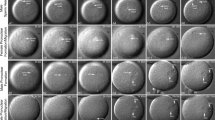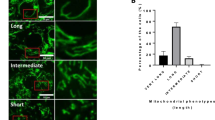Abstract
Factors affecting the efficiency of animal cloning remain to be elucidated1,2. Enucleation of recipient oocytes is a critical step in cloning procedures and typically is performed by aspirating a portion of the cytoplasm underlying the first polar body. Enucleation is evaluated using epifluorescence after Hoechst staining for DNA3,4,5,6, which may disrupt functions of the cytoplast, especially mitochondria7. Mitochondrial DNA in Dolly and other cloned sheep has been shown to derive exclusively from recipient oocytes8. Not only might evaluation of the aspirated karyoplast portion5 inadequately reflect the state of the cytoplast, it is also time consuming. Here we report a reliable, noninvasive technique for spindle imaging and enucleation of oocytes using a new microscope, the Pol-Scope9. The efficiency of enucleation was 100%, and only 5.5% of the oocytes' mitochondria entered the karyoplast upon Pol-Scope-directed removal of the spindle. Moreover, Pol-Scope imaging of spindles and micromanipulation did not compromise the developmental competence of reconstituted oocytes and cytoplasts.
This is a preview of subscription content, access via your institution
Access options
Subscribe to this journal
Receive 12 print issues and online access
$209.00 per year
only $17.42 per issue
Buy this article
- Purchase on Springer Link
- Instant access to full article PDF
Prices may be subject to local taxes which are calculated during checkout


Similar content being viewed by others
References
Robl, JM. Development and application of technology for large scale cloning of cattle. Theriogenology 51, 499–508 (1999).
Campbell, K.H.S. Nuclear equivalence, nuclear transfer, and the cell cycle. Cloning 1, 3–15 (1999).
Cibelli, J.B. et al. Cloned transgenic calves produced from nonquiescent fetal fibroblasts. Science 280, 1256–1258 (1998).
Liu, L., Dai, Y. & Moor, R.M. Nuclear transfer in sheep embryos: the effect of cell-cycle coordination between nucleus and cytoplasm and the use of in vitro matured ooctyes. Mol. Reprod. Dev. 47, 255–264 (1997).
Wilmut, I., Schnieke, A.E., McWhir, J., Kind, A.J. & Campbell, K.H.S. Viable offspring derived from fetal and adult mammalian cells. Nature 385, 810–813 (1997).
Cheong, H.T., Takahashi, Y. & Kanagawa, H. Relationship between nuclear remodeling and subsequent development of mouse embryonic nuclei transferred to enucleated oocytes. Mol. Reprod. Dev. 37, 138–145 (1994).
Smith, L.C. Membrane and intracellular effects of ultraviolet irradiation with Hoechst 33342 on bovine secondary oocytes matured in vitro. J. Reprod. Fertil. 99, 39–44 (1993).
Evans, M.J. et al. Mitochondrial DNA genotypes in nuclear transfer-derived cloned sheep. Nat. Genet. 23, 90–93 (1999).
Oldenbourg, R. A new view on polarization microscopy. Nature 381, 811–812 (1996).
Inoue, S. Polarization optical studies of the mitotic spindle. I. The demonstration of spindle fibers in living cells. Chromosoma 5, 487–500 (1953).
Hiramoto, Y. et al. Quantitative studies on the polarization optical properties of living cells. II. The role of microtubules in birefringence of the spindle of the sea urchin egg. J. Cell Biol. 89, 121–130 (1981).
Oldenbourg, R. Polarized light microscopy of spindles. Methods Cell Biol.. 61, 175–208 (1999).
Keefe, D., Tran, P., Pellegrini, C. & Oldenbourg, R. Polarized light microscopy and digital image processing identify a multilaminar structure of the hamster zona pellucida. Human Reprod. 12, 1250–1252 (1997).
Silva, C.P., Kommineni, K., Oldenbourg, R. & Keefe, D.L. The first polar body does not predict accurately the location of the metaphase II meiotic spindle in mammalian oocytes. Fertil. Steril. 71, 719–721 (1999).
Wakayama, T. & Yanagimachi, R. Fertilisability and developmental ability of mouse oocytes with reduced amounts of cytoplasm. Zygote 6, 341–346 (1998).
Peura, T.T., Lewis, I.M. & Trounson, A.O. The effect of recipient oocyte volume on nuclear transfer in cattle. Mol. Reprod. Dev. 50, 185–191 (1998).
Wakayama, T., Perry, A.C.F., Zuccotti, M., Johnson, K.R. & Yanagimachi, R. Full-term development of mice from enucleated oocytes injected with cumulus cell nuclei. Nature 394, 369–374 (1998).
Tsunoda, Y., Shioda, Y., Onodera, M., Nakamura, K. & Uchida, T. Differential sensitivity of mouse pronuclei and zygote cytoplasm to Hoechst staining and ultraviolet irradiation. J. Reprod. Fertil. 82, 173–178 (1988).
Latham, K.E.L. & Solter, D. Transplantation of nuclei to oocytes and embryos. Methods Enzymol. Vol. 225, 719–732 (1993).
Liu, Z. & Foote, R.H. Effects of amino acids on the development of in-vitro matured in-vitro fertilized bovine embryos in a simple protein-free medium. Human Reprod. 10, 2985–2991 (1995).
Acknowledgements
This work was supported in part by the National Institute of Health (NIH K081099) and Women and Infants Hospital/ Brown Faculty Research Fund. We thank Dr. Peter Smith and Shinya Inoue for encouraging advice.
Author information
Authors and Affiliations
Corresponding author
Rights and permissions
About this article
Cite this article
Liu, L., Oldenbourg, R., Trimarchi, J. et al. A reliable, noninvasive technique for spindle imaging and enucleation of mammalian oocytes. Nat Biotechnol 18, 223–225 (2000). https://doi.org/10.1038/72692
Received:
Accepted:
Issue Date:
DOI: https://doi.org/10.1038/72692
This article is cited by
-
Genetic mapping and QTL analysis in European hazelnut (Corylus avellana L.)
Molecular Breeding (2016)
-
Human oocytes reprogram adult somatic nuclei of a type 1 diabetic to diploid pluripotent stem cells
Nature (2014)
-
Enucleation and Formation of Cyto- and Karyoplasts and Their Fusion with Neuron Bodies
Neuroscience and Behavioral Physiology (2013)
-
Visualization of meiotic spindle and subsequent embryonic development in in vitro and in vivo matured human oocytes
Journal of Assisted Reproduction and Genetics (2007)



